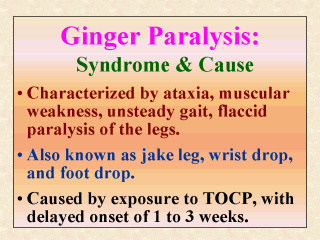 |
Like the
nutritional disease pellagra discussed in the last lecture, in the United States ginger
jake paralysis is a disease of the past. This paralysis, also nicknamed jake leg, is the
common type of organophosphate-induced delayed neuropathy (OPIDN). It is characterized by
muscular weakness, unsteady gait, ataxia, and flaccid paralysis of the limbs, particularly
the legs. Historically, the first organophosphate (OP) used as an insecticide was the
extremely potent acetylcholinesterase (AChE) enzyme inhibitor tetraethylpyrophosphate
(TEPP) developed in Germany in 1942. Other 200 some OP esters available today include the
more commonly used pesticides malathion and diazinon, and the widely used liquid
plasticizer tri-ortho-cresyl phosphate (TOCP). All OP are generally considered as
capable of inhibiting the AChE enzyme in mammals and insects. When AChE is severely
inhibited, the acetylcholine neurotransmitter will not be hydrolyzed but accumulated to
cause mild or fatal effects related to excessive nerve response. Some such adverse
neurologic effects have a delayed onset and, as stated above, are referred to as OPIDN.
Through its metabolic products, and hence presumably leading to a delayed (1 to 3 weeks)
type onset, TOCP can inhibit AChE and was proven to be responsible for the ginger jake
syndrome. One of its neurotoxic metabolites seen to be definitely associated with the jake
leg syndrome is tri-ortho-tolyl phosphate. The delayed peripheral paralysis
that follows the early syndrome of nausea, vomiting, and diarrhea is typically evidenced
by wrist drop and foot drop. |
